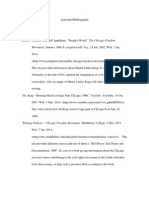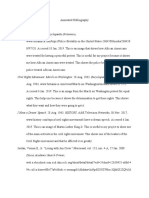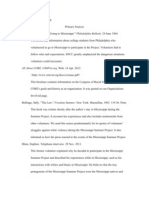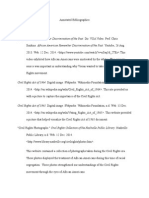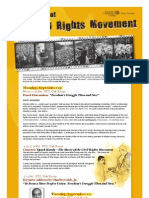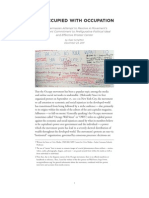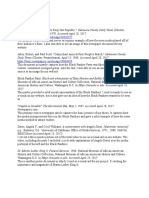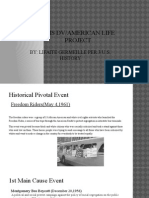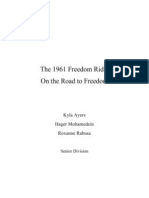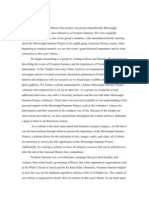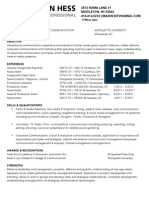Final Bib
Final Bib
Uploaded by
api-129672070Copyright:
Available Formats
Final Bib
Final Bib
Uploaded by
api-129672070Original Title
Copyright
Available Formats
Share this document
Did you find this document useful?
Is this content inappropriate?
Copyright:
Available Formats
Final Bib
Final Bib
Uploaded by
api-129672070Copyright:
Available Formats
Works Cited Primary Sources Alderwoman Vel Phillips Visits St. Boniface Church. 1967.
Historic Photo Collection, Milwaukee Public Library. Milwaukee Public Library Digital Collections. Web. 21 Apr. 2012. <http://content.mpl.org/u?/HstoricPho,6254>. I used this photo of Vel Phillips at St. Boniface Church on my website Anonymous. Letter to James Groppi. 17 Sept. 1967. Groppi Papers, 1956-1978. University of Wisconsin - Milwaukee. UWM March on Milwaukee Civil Rights History Project Digital Collections. Web. 25 Apr.2012.. <http://collections.lib.uwm.edu/u?/march,1239>. This letter was a critical letter to Father Groppi and I used it on my website to show polarized reactions. Aukofer, Frank. E-mail interview. 23 Feb. 2012. In this interview, Frank Aukofer, who was a civil rights journalist for the Milwaukee Journal at the time, answered questions for me that I had regarding the open housing marches that were not in his book. The interview was helpful in my understanding from a spectator standpoint, and from someone who was at the marches. Buresh, Bernice. Situation Grim, Core Leaders Say. Milwaukee Sentinel 4 Aug. 1967. Print. This article was very helpful because it was all about the reaction to the riots, and it gave community leaders thoughts on what was going to come next in Milwaukee, and on events of the past few days. It also included a photo of National Guardsmen and children in the inner core, which I used on my website. Civil rights march, James Groppi Center, circa 1967-1968. James Groppi Papers, 1956-1978, The Wisconsin Historical Society. UW Milwaukee March on Milwaukee Civil Rights
History Project. Web. 26 Feb. 2012. <http://collections.lib.uwm.edu/u?/march,671>. This photo was of Father Groppi leading a march. I used it in my website header. Fair Housing Demonstration, 1967. James Groppi Papers, 1956-1978, The Wisconsin Historical Society. UW Milwaukee March on Milwaukee Civil Rights History Project. Web. 26 Feb. 2012. <http://collections.lib.uwm.edu/u?/march,666>. This photo is of a Youth Council member most likely at a rally before a march. I used it in my website header. Fair housing march, James Groppi center, 1967. Groppi Papers, 1956-1978, The Wisconsin Historical Society. UW Milwaukee March on Milwaukee Civil Rights History Project. Web. 26 Feb. 2012. <http://collections.lib.uwm.edu/u?/march,659>. I used this photo in my website header. Johnston, Lyndon Baines. Fair Housing Act. Youtube.com. Web. 10 Mar. 2012. <http://www.youtube.com/watch?v=IDo9mb6-su4>. This video is of LBJ addressing the nation on the passing of the Civil Rights Act of 1968. I originally found video of this on History.com, but couldnt save it for editing to my computer, so I checked Youtube and it was there. King Jr., Martin Luther, Dr. Letter to James E. Groppi. 4 Sept. 1967. TS. Groppi Papers. Univertity of Wisconsin-Milwaukee Archives. This telegram of support from Dr. Martin Luther King Jr. I was able to find in the archives, and I used it on my website.
Maier, Henry. News Film Clip of Interview With Mayor Henry Maier About The Civil Disturbance, Held July 31, 1967 (with sound). WTMJ News Film Archives. WTMJ-TV. UWM March on Milwaukee Civil Rights History Project Digital Collections. Web. 23 Mar. 2012. <http://collections.lib.uwm.edu/u?/march,703>. This video is a television news
interview with Mayor Maier regarding the civil disturbances or riots on the first night of them. I used this video clip on my website. McKinney, Prentice. Interview. Freedom Walkers for Milwaukee Web Extra Prentice McKinney. MPTV.org. Milwaukee Public Television, 9 May 2011. Web. 29 Feb. 2012. <http://www.youtube.com/watch? v=hgn3Z6K_zao&list=WLA086D2DC4C286FCC&index=1&feature=plpp_video>. This was an interview of a former NAACP Commando. It helped me understand some of the circumstances in Milwaukee and nationwide dring the time. It also pushed me to pursue contacting Prentice, as I found his insight extremely interesting. - - -. Telephone interview. 20 Mar. 2012. This interview was really interesting, and I learned many things I didnt previously know about Milwaukees circumstances before the campaign for open housing. I also learned a lot about the social environment and relations with police, the mayor, and the clergy. We also spoke about the effects that the campaign had, or didnt have, on Milwaukee today. Meeting of NAACP commandos with James Groppi. 1967-1968. UWM March on Milwaukee Civil Rights History Project Digital Collection. Web. 14 Mar. 2012. <http://collections.lib.uwm.edu/u?/march,658>. This picture was of Youth Council Commandos having a meeting. I will use it on the page where I explain further what the Commandos did, and their ideology. The Milwaukee Journal 30 Aug. 1967. Print. This article gives an account of the first open housing march to the south side. It was helpful in realizing the extremities of the marches and the violence at them. NAACP March with James Groppi in the Center, 1968. Groppi Papers, 1956-1978, The
Wisconsin Historical Society. UW Milwaukee March on Milwakee Civil Rights History Project. Web. 26 Feb. 2012. <http://collections.lib.uwm.edu/u?/march,654>. This photo was of NAACP members and Father Groppi marching. I used this in my website header. News Film Clip of an Interview with Father Groppi and the Commandos after the Burning of the Freedom House, August 30, 1967. WTMJ-TV News Film Archives. WTMJ-TV. UWM March on Milwaukee Civil Rights History Project Digital Collections. Web. 22 Apr. 2012. <http://collections.lib.uwm.edu/u?/march,936>. This video was one of the first I saw of Father Groppi and some Youth Council members speaking, and it helped me learn more about their purposes and goals. I used clips of this video on my website. News Film Clip of Milwaukee Common Council Meeting Regarding Open Housing Legislation, September 19, 1967 (with sound). WTMJ News Film Archives. WTMJ-TV. UWM March on Milwaukee Civil Rights History Project Digital Collections. Web. 23 Mar. 2012. <http://collections.lib.uwm.edu/u?/march,720>. This video of a common council meeting I used to show reaction in the common council to the marches, and to help show one or two of the many reasons most aldermen had for not voting for open housing. News Film Clip of Vel Phillips Speaking on Fair Housing Legislation, June 13, 1967. WTMJ News Film Archives. WTMJ-TV. UWM March on Milwaukee Civil Rights History Project Digital Collections. Web. 7 Mar. 2012. <http://collections.lib.uwm.edu/u?/march,1361>. This was archival footage of a daily Milwaukee Common Council meeting, and it shows Vel Phillips addressing the common council on her open housing bill. I included a portion of this video on my website. Phillips, Vel. Telephone Interview. 1 Apr. 2012. This interview was very insightful and helped me understand a lot about the politics surrounding the open housing issue in Milwaukee. It was
a little bit difficult to set up a time to talk, but it ended up to be an extremely interesting interview to do. Roberts, Cecilia. Letter to James Groppi. 3 Sept. 1967. TS. Groppi Papers, Correspondance. University of Wisconsin - Milwaukee. This letter was of support to Father Groppi and the Youth Council. I used it on my website to show polarized reactions on the supporting side. I really found it interesting because it illustrates most of the controversial events relating to the open housing marches, and an outside view on them that I hadnt come across before. Roman Catholics: Support for Ajax. Time Magazine 22 Sept. 1967. Time Magazine Archive Collection. Web. 23 Apr. 2012. This article provided me with information on Catholic support, and lack of support mostly for Father Groppi and his radical actions as a priest. From it I used a quote made by Archbishop Cousins of Milwaukee during the time. Rozga, Margaret. Oral History Interview with Margaret (Peggy) Rozga. Interview by Michael Gordon. The March on Milwaukee Civil Rights History Project. The University of Wisconsin-Milwaukee, 19 June 2007. Web. 28 Feb. 2012. <http://collections.lib.uwm.edu/u?/march,1466>. This is one of a few oral history interviews of people who were involved in the open housing campaign. This interview was very helpful in understanding the end of the campaign. Tonights Curfew Is Last; Mayor Will Talk on TV. Milwaukee Journal 9 Aug. 1967. Print. This article gave me good insight on how the city was as the riots ended. It also had statements made by Mayor Meir and a photo that I included on my website. Unknown. Cartoon. Milwaukee Journal 11 Nov. 1967, Groppi Papers, University of Wisconsin Milwaukee Archives. Print. This comic provided me with a quote published about Henry Maiers go slow approach to social unrest that I used on my website.
Secondary Sources Aint Gonna Let Nobody Turn Me Round. Sing for Freedom: The Story of the Civil Rights Movement Through Its Songs. The Freedom Singers, 1990. MP3 file. This was one of the freedom songs sung by people involved in the civil rights activities in Milwaukee at the time, and I like it because it really applies to my topic, and it is my favorite arrangement of the song. I used this song on the homepage of my website. Aukofer, Frank A. City With a Chance. Milwaukee: Bruce Publishing Company, 1968. Print. This book was written by the civil rights journalist who was working for the Milwaukee Journal at the time. It explains his personal experiences in covering major events, including the riots in Detroit and Milwaukee, and open housing marches. It also helped me understand more the historical context in Milwaukee and cities like it in the urban north. It also explains the reactions of various well-known figures in Milwaukee at the time, including actual quotes and statements, which helped me in understanding the reaction from various groups and people. Black Population Growth Rates for Selected Midwestern Cities, 1930-1960. Map. More than One Struggle: The Evolution of Black School Reform in Milwaukee. By Jack Dougherty. University of North Carolina Press, 2004. Print. This book I mostly found helpful for maps and charts of the demographics of Milwaukees African American community historically leading up to civil rights in Milwaukee, and I used two of them on my website. Black Population in Milwaukees Inner Core, 1960. Map. More than One Struggle: The Evolution of Black School Reform in Milwaukee. By Jack Dougherty. University of North Carolina Press, 2004. Print. This book I mostly found helpful for maps and charts of the demographics of Milwaukees African American community historically leading up to civil
rights in Milwaukee, and I used two of them on my website. Dougherty, Jack. African Americans, Civil Rights, and Race Making in Milwaukee. Perspectives on Milwaukees Past. Ed. Margo Anderson and Victor Greene. Chicago: University Of Illinois, 2009. Print. This book describes Milwaukees African American history and Civil Rights Movement well, and helped me understand the political historical context better. 4 Decades Later, Poverty Persists. JS Online. Milwaukee Journal Sentinel, 1 Aug. 2007. Web. 10 Mar. 2012. This article was most likely written for the 40th anniversary of Milwaukees riots. It includes information on the riots, and the social and economic circumstances in which they occurred in 1967. The article also includes a follow up analysis of the neighborhoods where the riots occurred, and compare statistics from 1967 to those of 2007. Fair Housing Act of 1968. History.com. A&E Television Networks. 1996-2012. Web. 15 May 2012.< http://www.history.com/topics/fair-housing-act>. This article on the passage of the 1968 Civil Rights Act helped me understand what was going on nationally during the campaign in Milwaukee, and how lobbying in Congress helped spur the passage of the Act among other things. Freedom Walkers for Milwaukee. Milwaukee Public Television. MPTV, Milwaukee, 11 June 2011. MPTV.org. Web. 29 Feb. 2012. <http://www.mptv.org///?id=833>. This documentary was about civil rights in Milwaukee, and also had a good amount of information on open housing. This documentary led me to full interviews of the people interviewed in the documentary. Gurda, John. The Making of Milwaukee. Milwaukee: Milwaukee County Historical Society, 1999. Print. This book was really instrumental in helping me realize social conditions in the
decades leading up to the 1960s and Milwaukees civil rights movement, including pictures. It helped me look into events such as the highways being put in, discrimination in employment, and white flight to the suburbs. - - -. Personal interview. 9 May 2012. This interview with a Milwaukee historian helped me put into context the civil rights movement in the city. He also shared with me his own personal stories of marching with the Youth Council at one time, and perspective on various reactions of city leaders to civil rights.
James E. Groppi Unity Bridge. 20 Apr. 2012. Personal photograph by author. On one of my trips to Milwaukee, I was able to take a visit to the places where everything I was studying happened, and on this trip I took these two photos on the Unity Bridge. Jones, Patrick D. Not a Color, but an Attitude: Father James Groppi and Black Power Politics in Milwaukee. Groundwork: Local Black Freedom Movements in America. Ed. Jeanne Theoharis and Komozi Woodard. New York City: New York University Press, 2005. This chapter helped me understand the lobbying that was going on in Washington, D.C. during the national struggle for open housing. It also helped me understand how things like the Black Nationalism movement and the Black Panther ideology affected views on Milwaukees campaign. - - -. The Selma of the North Civil Rights Insurgency in Milwaukee. Cambridge: Harvard UP, 2009. Print. This book was one of the most helpful sources for me. It had extensive information on Milwaukees entire civil rights movement, the history behind it, and full notes and bibliography in the back of the book which helped me find things in the archives, and many of my sources. I also used pictures and quotes from interviews in the book on my website.
- - -. Telephone interview. 18 Apr. 2012. This interview was very helpful in my realization on how significant Milwaukees campaign was. Patrick Jones also helped me confirm some of my personal analyses of the reactions of groups and people in Milwaukee. Llorens, David. Miracle in Milwaukee. Ebony Magazine Nov. 1967. Google Books. Web. 28 Feb. 2012. <http://books.google.com/? id=xtsDAAAAMBAJ&pg=PA29&lpg=PA29&dq=ebony+magazine+milwaukee+open+ho using&source=bl&ots=13O7HWwt8C&sig=Kj8LZiqX9eDO8jqJjQNDwEDIs0k&hl=en&s a=X&ei=LLZNT_32INPpgQe6nOGuAg&sqi=2&ved=0CEIQ6AEwAw#v=onepage&q&f =false>. This article was interesting to read because it gave an outside view on the events in Milwaukee, and an inside look into the daily activities of commandos and youth council members. This article also had pictures that I used on my website. Lowe, Mike. Milwaukee Earns Dubious Distinction of Most Segregated City in America. Chicago Tribune 1 Apr. 2011. ChicagoTribune.com. Web. 23 Mar. 2012. This article gave me good information on Milwaukees problems that still reflect the problems of the 1960s in terms of segregation in housing. Maier, Henry W. The Mayor Who Made Milwaukee Famous. Lanham, Maryland: Madison Books, 1993. Print. In his autobiography, Maier explains thoroughly what his and the common councils beliefs were on open housing at the city level only, and gave me a deeper perspective on the consequences that central cities would face if city only legislation was passed. From it I also learned a lot about the problems facing American cities at the time such as white flight to the suburbs, and tax problems in cities due to it. Meyer, Stephen Grant. As Long as They Dont Move Next Door: Segregation and Racial Conflict in American Neighborhoods. Lanham, Maryland: Rowman & Littlefield, 2000. Print. In
this book, the author analyzes deeply the causes of housing segregation, putting focus on movements to end it and gain open housing legislation, including Milwaukees movement. I really like this book and found it helpful in finding out the history behind segregated housing in cities. Milwaukee Timeline. Milwaukee County Historical Society. Milwaukee County Historical Society, 2011. Web. 20 Apr. 2012. <http://www.milwaukeehistory.net/outreach/timeline/>. This article gave me more information on the problems facing Mayor Zeidlers administration during the 50s and caused me to look more into African American migration to Milwaukee as well as the beginnings of racial confrontation in the city. Miner, Barbara. Valiant Lady Vel. Milwaukee Magazine 8 Nov. 2007. Inside Milwaukee. Web. 14 Mar. 2012. <http://www.insidemilwaukee.com//>. This article was written during the 40th commemoration of the open housing marches, and features parts of an interview with Vel Phillips, which gave me lots of information on her personal experiences and opinions, as well as background information on her before I interviewed her. Rozga, Margaret. March on Milwaukee. Wisconsin Magazine of History Summer 2007: 28-41. WisconsinHistory.org. Web. 30 Dec. 2011. <http://content.wisconsinhistory.org//.php? CISOROOT=/&CISOPTR=49374&CISOSHOW=49343>. This article was written for the 40th anniversary of the marches. It was written by the wife of the late James Groppi. It is a full history of the events from the eyes of someone who experienced them first hand, and it was a good source of both information and pictures. It also included notes at the end, which led me to more sources on the topic. - - -. 200 Nights and One Day. Milwaukee: Benu Press, 2009. Print. This was a book of poems written by the wife of the late James Groppi, who was also an activist, and who is currently
a college English professor. The poems are all written from the viewpoint of real people involved, and based on actual events. They helped me understand more of the personal experiences of people involved in the whole civil rights movement in Milwaukee. It also includes a few pictures and an entire timeline of the events of the Open Housing movement, which helped me greatly in being able to understand how events fit together chronologically. Taylor, Chuck, prod. Decade of Discontent. WMTV, Madison, 1981. YouTube.com. Web. 23 Mar. 2012. <http://www.youtube.com/?v=2vmygdAt_Xk>. This was a documentary about Milwaukee during the 1960s, focusing on social problems of the time and Milwaukees civil rights movement. I used clips of this documentary on my website. Yinger, John. Closed Doors, Opportunities Lost: The Contuinuing Costs of Housing Discrimination. New York: Rusell Sage Foundation, 1995. Print. Although this book went into thorough detail on housing discrimination, I found it particularly helpful in finding information on open housing legally across the country, and current statistics.
You might also like
- Annotated BibliographyDocument3 pagesAnnotated Bibliographyericad09No ratings yet
- Annotated Bibliography FinalDocument4 pagesAnnotated Bibliography Finalapi-283685409No ratings yet
- Picturing America: Picturing America Portfolio Contains 40 Large High-Quality Prints ThatDocument5 pagesPicturing America: Picturing America Portfolio Contains 40 Large High-Quality Prints Thatlaurabrown63No ratings yet
- ProcesspaperDocument6 pagesProcesspaperapi-353236641No ratings yet
- Primary Sources: Famous Whiskey Insurrection in Pennsylvania. 1794. Photograph. Lib. of Cong., WashingtonDocument5 pagesPrimary Sources: Famous Whiskey Insurrection in Pennsylvania. 1794. Photograph. Lib. of Cong., WashingtonpinkdanncerNo ratings yet
- Summary of Research & BibliographyDocument2 pagesSummary of Research & BibliographyagneslillygeeNo ratings yet
- Annontated Bibliography-NhdDocument5 pagesAnnontated Bibliography-Nhdapi-534156288No ratings yet
- Final BibDocument4 pagesFinal Bibapi-207945604No ratings yet
- Sources For NHDDocument9 pagesSources For NHDapi-445243459No ratings yet
- NHD 2018-2019 Annotated Biblography 1Document8 pagesNHD 2018-2019 Annotated Biblography 1api-444828433No ratings yet
- Annotated BibliographyDocument33 pagesAnnotated BibliographyAmanda CastilloNo ratings yet
- Annotated Bibliography - States - FinalDocument20 pagesAnnotated Bibliography - States - FinalKaizenponoNo ratings yet
- NoodlebibDocument11 pagesNoodlebibUmer EhsanNo ratings yet
- Bibliograhy Old PDFDocument15 pagesBibliograhy Old PDFAlexLampertNo ratings yet
- Annotated BibliographyDocument40 pagesAnnotated Bibliographyapi-127884077No ratings yet
- Annotated BibliographyDocument18 pagesAnnotated Bibliographycivilrightsmovement6No ratings yet
- It Started in Wisconsin: Dispatches from the Front Lines of the New Labor ProtestFrom EverandIt Started in Wisconsin: Dispatches from the Front Lines of the New Labor ProtestRating: 5 out of 5 stars5/5 (2)
- HB 5 C 32083877 EidnDocument2 pagesHB 5 C 32083877 Eidnapi-256259690No ratings yet
- NHD 2012-13 BibDocument11 pagesNHD 2012-13 Bibapi-195484562No ratings yet
- SS8H11B - SS8H11B Stations and InstructionsDocument19 pagesSS8H11B - SS8H11B Stations and InstructionsTara Holder StewartNo ratings yet
- Annotated BibliographyDocument17 pagesAnnotated Bibliographymam16No ratings yet
- Annotated BibliographyDocument12 pagesAnnotated Bibliographymam16No ratings yet
- Like Wildfire: The Rhetoric of the Civil Rights Sit-InsFrom EverandLike Wildfire: The Rhetoric of the Civil Rights Sit-InsSean Patrick O'RourkeNo ratings yet
- Video Lecture Transcript - America in The SixtiesDocument16 pagesVideo Lecture Transcript - America in The SixtiessamiaNo ratings yet
- Bibliography of Primary and Secondary SourcesDocument5 pagesBibliography of Primary and Secondary SourcesJustyna KosinskaNo ratings yet
- 1519817893Paper5;Module34;ETextDocument12 pages1519817893Paper5;Module34;ETextnbhat6803No ratings yet
- BibliographyDocument10 pagesBibliographyapi-744967952No ratings yet
- Bayview's Last Stand: Protecting Historic Black Neighborhoods - John William Templeton Speaker FilmmakerDocument5 pagesBayview's Last Stand: Protecting Historic Black Neighborhoods - John William Templeton Speaker FilmmakerJW TempletonNo ratings yet
- Nhdbibliography 3Document7 pagesNhdbibliography 3api-350974750No ratings yet
- Spider Web The Birth of American Anti-Communism (2016)Document369 pagesSpider Web The Birth of American Anti-Communism (2016)Chemical CesiumNo ratings yet
- Civil Rights TimelineDocument6 pagesCivil Rights TimelineSiddhaant JainNo ratings yet
- Martin Luther King QuestionsDocument2 pagesMartin Luther King Questionsfrank sinatraaNo ratings yet
- v2 CivilRightsMovementPoster09 11Document1 pagev2 CivilRightsMovementPoster09 11Lisa M. WalzNo ratings yet
- Preoccupied With Occupation: A Habermasian Attempt To Resolve A Movement's Concurrent Commitment To Prefigurative Political Ideal and Effective Protest CenterDocument23 pagesPreoccupied With Occupation: A Habermasian Attempt To Resolve A Movement's Concurrent Commitment To Prefigurative Political Ideal and Effective Protest CenterGabi SchaffzinNo ratings yet
- A Past That Won't Rest: Images of the Civil Rights Movement in MississippiFrom EverandA Past That Won't Rest: Images of the Civil Rights Movement in MississippiNo ratings yet
- BiblioDocument5 pagesBiblioapi-355536701No ratings yet
- Annotated BibliographyDocument6 pagesAnnotated Bibliographyapi-536933216No ratings yet
- I AM A MAN: Photographs of the Civil Rights Movement, 1960-1970From EverandI AM A MAN: Photographs of the Civil Rights Movement, 1960-1970Rating: 4.5 out of 5 stars4.5/5 (2)
- This Dv-American LifeDocument10 pagesThis Dv-American Lifeapi-287096303No ratings yet
- BibliographiesDocument2 pagesBibliographiesKathy StriblingNo ratings yet
- Protest Songs WebquestDocument11 pagesProtest Songs WebquestAngel Angeleri-priftis.No ratings yet
- Civil Rights Movement Web QuestDocument6 pagesCivil Rights Movement Web QuestCharles CogginsNo ratings yet
- NhdprocesspaperDocument3 pagesNhdprocesspaperapi-127034683No ratings yet
- Reawakening The Radical ImaginationDocument8 pagesReawakening The Radical ImaginationChristopherGundersonNo ratings yet
- Martin Luther King JRDocument3 pagesMartin Luther King JRapi-275245529No ratings yet
- Bikes and Bloomers: Women's Ride To FreedomDocument9 pagesBikes and Bloomers: Women's Ride To Freedomapi-195261472No ratings yet
- Process PaperDocument2 pagesProcess Paperapi-127884077No ratings yet
- Sex Scene Edited by Eric SchaeferDocument30 pagesSex Scene Edited by Eric SchaeferDuke University Press100% (2)
- Untitled Notebook 2Document7 pagesUntitled Notebook 2GracieGirlNo ratings yet
- Martin Luther KingDocument14 pagesMartin Luther KingBenjamin MohammadnabiNo ratings yet
- BibliographyDocument2 pagesBibliographyapi-391014053No ratings yet
- SPLC Civil Rights Activity Book WebDocument27 pagesSPLC Civil Rights Activity Book WebShaun Johnson0% (1)
- Black History Mont1Document4 pagesBlack History Mont1Mokshitha Reddy YanamalNo ratings yet
- March On WashingtonDocument5 pagesMarch On Washington76153No ratings yet
- Student Facing - Webquest - Civil Rights Movement 1950s and 1960s Research ActivityDocument5 pagesStudent Facing - Webquest - Civil Rights Movement 1950s and 1960s Research Activity851882No ratings yet
- Project Drive Safer Cover LetterDocument2 pagesProject Drive Safer Cover LetterTMJ4 NewsNo ratings yet
- Document 15Document466 pagesDocument 15Pcnhs SalNo ratings yet
- Maximilian Hess - ResumeDocument2 pagesMaximilian Hess - ResumeMaximilianHessNo ratings yet
- TMJ4 2023 Contest RulesDocument6 pagesTMJ4 2023 Contest RulesTMJ4 NewsNo ratings yet
